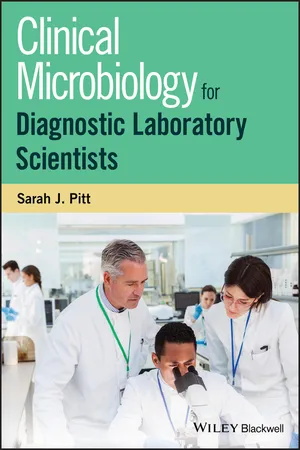
Clinical Microbiology for Diagnostic Laboratory Scientists
- English
- ePUB (mobile friendly)
- Available on iOS & Android
Clinical Microbiology for Diagnostic Laboratory Scientists
About this book
A modern, evaluative, and integrative approach to diagnostic microbiology encouraging problem-solving in the clinical laboratory context through the use of examples to illustrate clinical and diagnostic issues
Clinical Microbiology for Diagnostic Laboratory Scientists is designed to encourage readers to develop a way of thinking that can be applied to any diagnostic scenario in microbiology. Through consideration of a selected range of infections caused by pathogenic bacteria, viruses, fungi, protozoa, and helminths, the book encourages readers to explore connections between the available information about clinical symptoms, pathogenesis of infections, and the approaches used in laboratory diagnosis, in order to develop new insights.
The book begins with an introductory chapter that outlines the scope of clinical diagnostic microbiology and the key areas for the laboratory scientist to be aware of. The subsequent six chapters review a type of infection in depth, using particular pathogenic microorganisms to illustrate salient points. At the end of each chapter there are three exercises related to management of a diagnostic service and assessing the suitability of test methods to specific contexts. There are no right or wrong answers to these, but the reader can discuss them with their laboratory colleagues or university tutor.
- Makes extensive use of published research in the form of journal articles, publically available epidemiological data, professional guidelines, and specialist websites
- Stimulates the reader in critical appraisal of published evidence and encourages problem-solving in the laboratory
- Outlines the scope of clinical diagnostic microbiology and the key areas for the laboratory scientist to be aware of
- Considers topics relevant to professional scientists working in the area of diagnostic microbiology
Clinical Microbiology for Diagnostic Laboratory Scientists is ideal for post graduate scientists intending to pursue careers in diagnostic clinical microbiology and for biomedical scientists, clinical scientists, and full time students studying for upper level qualifications in biomedical science, microbiology, or virology.
Frequently asked questions
- Essential is ideal for learners and professionals who enjoy exploring a wide range of subjects. Access the Essential Library with 800,000+ trusted titles and best-sellers across business, personal growth, and the humanities. Includes unlimited reading time and Standard Read Aloud voice.
- Complete: Perfect for advanced learners and researchers needing full, unrestricted access. Unlock 1.4M+ books across hundreds of subjects, including academic and specialized titles. The Complete Plan also includes advanced features like Premium Read Aloud and Research Assistant.
Please note we cannot support devices running on iOS 13 and Android 7 or earlier. Learn more about using the app.
Information
1
Overview of Clinical Diagnostic Microbiology
1.1 Introduction
1.2 Organisation and Management of Diagnostic Microbiology Services
1.3 Techniques
Table of contents
- Cover
- Title Page
- Table of Contents
- Preface
- Acknowledgements
- 1 Overview of Clinical Diagnostic Microbiology
- 2 Infections of the Blood
- 3 Respiratory Tract Infections
- 4 Gastrointestinal Infections
- 5 Congenital, Perinatal and Neonatal Infections
- 6 Sexually Transmitted Infections
- 7 Infections in Immunocompromised Patients
- Appendix: Answers for Case Studies
- Index
- End User License Agreement